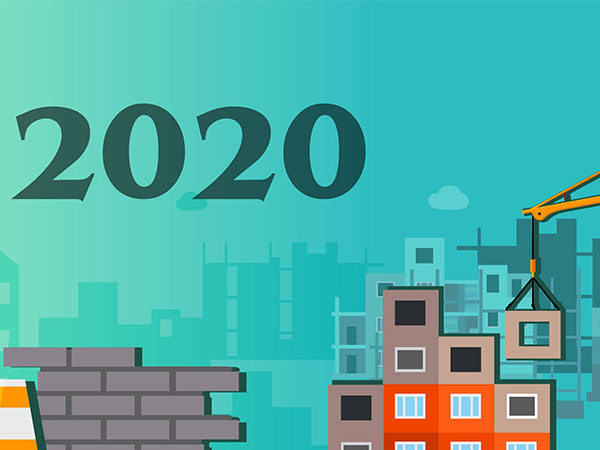2020 Construction Industry Trends
The new building numbers show a thriving and sustainable market. Rising building costs and workforce problems, in addition to new legislation, minimize the margin for error and waste.
For a market slower to innovation and trends, the same building trends continue year after year with significantly different nuances. New technology continues to transform construction site, boost project winning capacity and improve profit margins. Trends and movements shift the positions of manufacturing and frontline workers.
When manufacturing gets more dynamic and demand changes, harnessing these developments in the construction industry would prove beneficial to every construction group. Read on for the 2020 building developments to help you remain competitive and achieve an edge in the industry.
Efficiency-improvement technology
The potential impact of blockchain technologies on building. Experts see it as a powerful component in delivering a more stable, fast-moving workflow that brings more trust and efficiency to all interested parties.
Smart contracts give both companies a common business mechanism in a project, allowing them to purchase, track and pay for resources. Instead of contracts and monitoring deliverables by all different partners, companies may use smart contacts as an all-in-one tracking mechanism where guidelines and deadlines are set and implemented by the blockchain. This system would ensure quicker closures, improved surveillance, better project monitoring, and an integrated supply chain Build your efficient building with Construction Company in Pondicherry
Drones on construction
Drone use in the building industry remains one of the fastest growing phenomena, with consumption rising 220 percent year-over-year. The technology provides much more applications than aerial photography for land and commercial efforts.
Today’s drones are used to easily monitor vast areas over long distances, creating useful heat maps and thermal photographs. Advancing drone tech offers real-time, actionable data that can be used to make swift decisions, streamlining the entire development process.
Personal protection and infrastructure failure are the major fields of building liability. Drones may be increasingly used to achieve heights and work as human staff to avoid injuries. Every year, building equipment robbed between $200 and $0.5 billion. As on-site surveillance vehicles, drones may be leveraged to minimize labor costs and the possibility of burglary. That keeps projects planned and going faster.
More sophisticated future applications include tracking equipment use and integrating AI to coordinate moving equipment.
Greater reality (AR) in building
Next year the virtual reality is projected to be worth $80 billion as it continues to have new technologies. On the customer front, AR means efficient project staging, making pre-construction projects tangible to buyers and tenants.
AR enables the use of wearable devices and 360-degree content for developers to enable:
- 3D visualization of upcoming work surrounding them
- Entirely automated assessment
- Cheap and reliable architectural and structural simulation
- Training and hazard models
Building Information Modeling
Building IT lets business leaders stand out for greater performance. BIM helps buildings and services to generate software representation. The simplicity of handling these models and exchanging data will allow superior parts prefabricated components, leading to timely, accurate completion. Autodesk defines it as an intelligent 3D model-based process to support construction and infrastructure managers.” Get 3D model with Builders in Pondicherry
According to Finances Online, 2020’s top BIM tech options include:
- Autodesk BIM 360
- Tekla BIMsight
- Revit
- Navisworks
- BIMobject
- BIMx
Building Information Program
Getting great construction management software is a critical component to stay competitive, develop a valuable company, and master operational performance.
Although and cloud service can have significantly different functionality and capabilities, the best holistically handle end-to-end needs from RFIs to data compilation, file sharing with mobile teams, budgeting, document storage, payroll and HR, procurement and project management tracking.
Top-reviewed building tech applications in 2020 include:
- Procore
- CoConstruct
- Buildertrend
- ProjectSight
- RedTeam
- Quick Base
- Projul
- PlanGrid
- Sage 300 Construction and Real Estate
Modular, prefabricated style
As the infrastructure enabling modular units installed off-site advances, we should expect even more activity in this market. With this approach, several smaller builders developed creative green building designs, increasing their business exposure and raising customer confidence.
Green House
Green building has become the expected norm among homebuyers, renters, and landlords. Unfortunately, many affordable and eco-friendly features remain luxurious despite long-term savings. This will change significantly over the next few years. builds your dream house with Top Construction company in Pondicherry
Whether in the building industry, demand from end users or legislation, hopes are that renewable energy will continue to rise as a percentage of total consumption. That’s a big market, as buildings already account for 40% of our national electricity usage and 30% of greenhouse gas emissions.
Green architecture involves all technologies to lower the carbon emissions of a building and material and building models to reduce water use. Perhaps an even greater green-building driver is evidence of its importance for inhabitants. Research indicates that green buildings can have beneficial physiological and psychological consequences.
Improved protective devices
Also, the industry is seeing an increase in computers capable of detecting basic safety problems and removing such risks one by one. Work boots technologies allow them to connect to Wi-Fi and warn others if a user fall.
Beyond worker gear, we also see robots replacing human workers. This ranges from “mules” to scaffolding and bricklaying machines. However, several businesses say robots do not replace human workers.
More accurately, they are transforming human roles—mostly, growing human decision-making and making space for new, higher-level jobs. One of the most significant is the opportunity to convert data results into actionable observations.
We now have 3D printing that can reduce transportation hazards and environmental sensors to monitor noise, heat and wind at construction sites and act as alarms to evacuate construction workers and shift expensive construction machinery.
Persistent job shortages
One of the most significant building developments in recent years was a troubling Laboure shortage. We’re in the building cycle where labor is costly and competitive. Robots may take up a lot of the slack, but few human replacement workers exist in the pipeline.
Increased material prices
As of October 2020, according to the General Contractors Association, building material prices rose 7.4 percent year-over-year. Higher interest rates are expected to compound these expense forms, resulting in more strain on overall building. Technologies including drones, AR, and BIM would be crucial to help sustain project volume and battle this cost burden.


